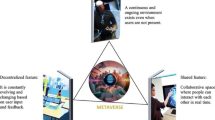Abstract
Educational institutions may form virtual learning communities by cooperating with others to develop online academic activities. In the cloud, communities make up a grid of expertise, which is built with the learning resources that each organization shares with other pairs. Currently little is known about the problems that prevent the formation of the grid of Expertise in Virtual Learning Communities. Such techniques are not being implemented optimally and efficiently. In this paper we present a description of these problems. This work is important for community members (directors, teachers, researchers and practitioners) because it offers a conceptual framework that helps understand these scenarios and can provide useful design requirements when generating learning services for the community. We also propose an experience implemented at the University of Cartagena (Colombia) in which virtual learning communities have been integrated obtaining an alternative solution to the current problems. We believe that the result of this experience could solve the technological isolation to build communities efficiently and optimally.









Similar content being viewed by others
References
Advanced Distributed Learning (2004) SCORM, Sharable Content Object Reference Model. http://www.adlnet.gov. Accessed 22 May 2004
Akram A, Allan R (2006) Organization of grid resources in communities. In: Proceedings of the 4th international workshop on middleware for grid computing—MCG ’06, vol 194, 27 Nov–1 Dec 2006. Melbourne, Australia. doi:10.1145/1186675.1186697
Calegari D, Viera M, Motz R (2005) Design of a service-oriented architecture for federated systems. J Comput Sci Technol (Special Issue, XI Argentine Congress on Computer Science—CACIC) 5(4):167–172
Grainne C, Juliette C (2010) The design of Cloudworks: applying social networking practice to foster the exchange of learning and teaching ideas and designs. In: Computers & education. Learning in digital worlds: selected contributions from the CAL 09 conference, vol 54(3), pp 679–692
Ferretti S, Mirri S, Muratori LA, Roccetti M, Salomoni P (2008) E-learning 2.0: you are WeLCoME!. In: Proceedings of the 2008 international cross-disciplinary conference on web Accessibility. W4A’08, vol 317. Beijing, China, pp 116–125
Hunter MG, Stockdale R (2009) Taxonomy of online communities: ownership and value propositions. In 42nd Hawaii international conference on system sciences, 2009. HICSS ’09, pp 1–7, 5–8. doi:10.1109/HICSS.2009.418
IEEE Learning Technology Standards Committee—LTSC (2002) IEEE P1484.1/D9, 2001-11-30 Draft Standard for Learning Technology—Learning Technology Systems Architecture (LTSA). http://ltsc.ieee.org/wg1/. Accessed 22 May 2002
IEEE Learning Technology Standards Committee—LTSC (2005) IEEE 1484.12.1-2002: Draft Standard for Learning Object Metadata. http://ltsc.ieee.org/wg12/files/LOM_1484_12_1_v1_Final_Draft.pdf. Accessed 20 May 2005
Iriberri A, Leroy G (2009) A life-cycle perspective on online community success. ACM Comput Surv 41(2):1–29
Isla Montes JL, Gutierrez Vela FL, Rodriguez PP (2007) A pattern-based approach for conceptual modeling of cooperative systems. IEEE Latin Am Trans 5(4):204–210. doi:10.1109/TLA.2007.4378507
Kim KR, Moon NM (2012) Designing a social learning content management system based on learning objects. Multimed Tools Appl. doi:10.1007/s11042-012-1014-3
Liaw S-S, Chen G-D, Huang H-M (2008) Users’ attitudes toward web-based collaborative learning systems for knowledge management. Computers & Education 50(3):950–961
Miroslav M, Milos̆ M (2011) Starc̆ević Dus̆an, learning object repurposing for various multimedia platforms. Multimed Tools Appl. doi:10.1007/s11042-011-0964-1
Object Management Group—OMG (2007) Unified modeling language. http://www.omg.org/spec/UML. Accessed 7 Dec 2007
OpenSimulator (2010) http://opensimulator.org. Accessed 14 May 2010
Ribón RJ, de Miguel TP, Ortíz JH (2009) Joint degrees in e-learning environments. In: Proceedings of the 2009 Euro American conference on telematics and information systems: new opportunities to increase digital citizenship, Prague, Czech Republic, 3–5 June 2009
Rodríguez JC, García LJ, de Miguel TP, Kim T (2011) Grid of learning resources in e-learning communities. In: Proceedings of the 2011 international conference on Multimedia, Computer Graphics and Broadcasting (MulGraB 2011), part II, CCIS, vol 263, 8–10 Dec 2011. Jeju Island, Korea, pp 295–299
SecondLife (2010) http://secondlife.com/. Accessed 14 May 2010
SLOODLE (2010) Simulation linked object oriented dynamic learning environment. http://www.sloodle.org/moodle/. Accessed 14 May 2010
The Apache Software Foundation (2010) Apache Tomcat. http://tomcat.apache.org/. Accessed 14 May 2010
The Apache Software Foundation (2010) Web services—axis. http://ws.apache.org/axis/. Accessed 14 May 2010
Weller M (2007) The distance from isolation: why communities are the logical conclusion in e-learning. Comput Educ 49(2):148–159
Acknowledgements
This work was supported by the Agencia Española de Cooperación Internacional para el Desarrollo (AECID, Spain) through Acción Integrada MAEC-AECID MEDITERRÁNEO A1/037528/11. This work was also supported by the Security Engineering Research Center, granted by the Ministry of Knowledge Economy (MKE, Korea).
Author information
Authors and Affiliations
Corresponding author
Rights and permissions
About this article
Cite this article
Rodríguez Ribón, J.C., García Villalba, L.J., de Miguel Moro, T.P. et al. Solving technological isolation to build virtual learning communities. Multimed Tools Appl 74, 8521–8539 (2015). https://doi.org/10.1007/s11042-013-1542-5
Published:
Issue Date:
DOI: https://doi.org/10.1007/s11042-013-1542-5




